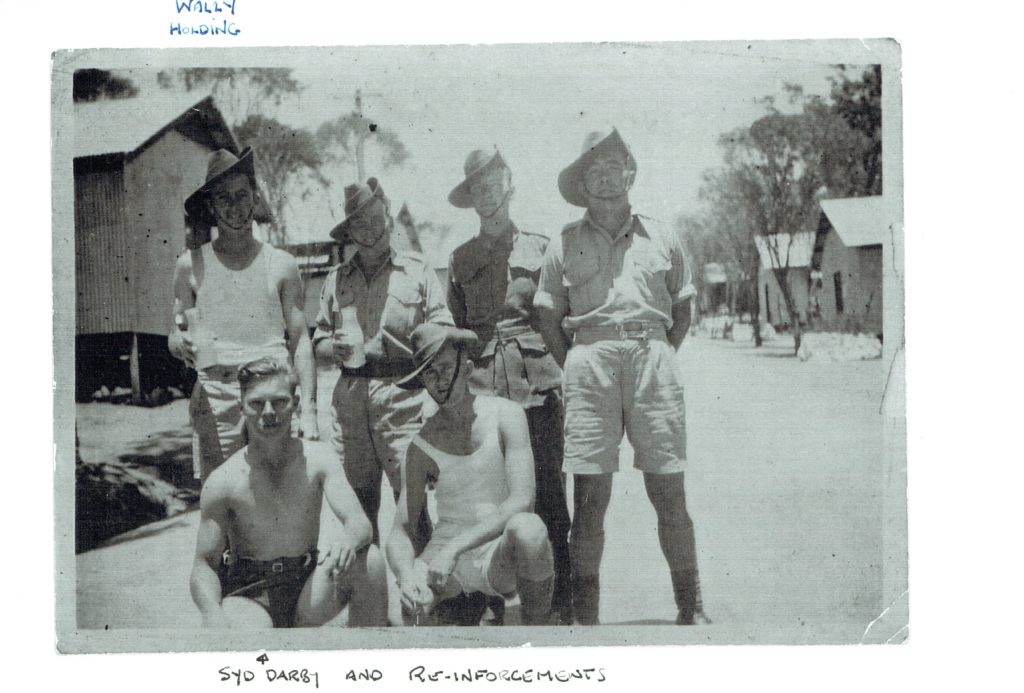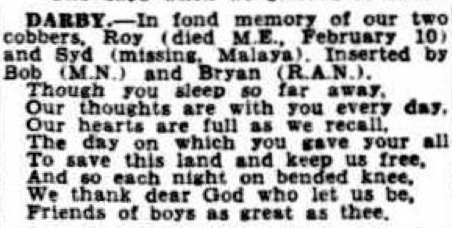The Soldier's Details

- Surname:
- Darby
- First Name:
- Sydney James
- Nick Name:
- Kid or Syd
- Rank:
- Private
- Regimental #:
- WX15873
- Company:
- ‘E’ Company, Special Reserve Battalion, No. 2 Platoon
- Enlisted:
- 19.08.1941
- DOB:
- 16.07.1922
- Place of Birth:
- Epping Green, Essex, England
- Father's Name:
- William Robert Darby
- Mothers's Name:
- Edith Hannah Darby (nee Neville)
- Religion:
- Church of England
- Pre-war Occupation:
- Shop Assistant
- Memorial:
- Epitaph, Singapore Memorial, Column 136, Age 19.
- Cause of Death:
- Killed in Action. Soldier is thought to have been killed by a Japanese sniper whilst on patrol.
- Place of Death:
- Sungei Kranji-Sungei Jurong Defence Line
- Date of Death:
- 10.02.1942
General Description
Sydney Darby died aged 19 years. He enlisted AIF 19 Aug 1941 and was later transferred to 2/4th Reinforcements, ‘E’ Company, Special Reserve Battalion. The men were given a few days leave to see their families and return to Northam Tranining Camp. They were entrained to Fremantle boarded ‘Aquitania’ which was anchored only one night, 15th January before sailing for Singapore the following day. With Darby were his Mundijong mates Steve Gleeson (worked Burma-Thai Railway had leg amputated) George Leipold (KIA) and Bill Swann.
The first time they faced fear and the reality of war was after they arrived at Singapore, however on the ship excitement would have taken over! Fighting for Australia!
Sydney Darby was KIA killed by a Japanese sniper whilst on patrol on 10th February 1942, the day prior to the Company running into a Japanese Ambush at South West Bukit Timah. There were two other 2/4th men killed on same patrol from No. 2 Platoon WX17615 Ernie Thomsett also 19 years and Ernie Munday 25 years. There was a terrible loss of life with about 88 of the 200 men surviving.
Wallly Holding said “Syd Darby was only a youngster, but was most popular in the Company. He was known as the ‘Kid’.”
Please read further about ‘E’ Company
___________
Syd’s father had served in the British Army in WW1 and been exposed to mustard gas. Because of his health he was advised to seek a warmer climate to live. With his wife and two young sons, Roy and Syd the family sailed to Albany in 1924 on “Demosthenes” and firstly joined a Group Settlement at Cowaramup. The family grew to 9 children. Finally after 1934, the Darby family moved to Holyoake near Dwellingup, where most residents were employed in the local timber industry. Please read further about Group Settlement.


By 1934 the Darby family were selling their farm at Cowaramup.

Holyoake is within the Murray Shire, approximately 85 kms south of Perth and about half an hour drive to Mundijong.
‘Holyoake No.1 Mill was burnt down 1929 and replaced by a smaller mill which operated until 1959. The townsite was a thriving community until destroyed by fire in 1961.
The Holyoake townsite was supported by a large number of shops with an excellent variety of merchandise.
Creek Bros Store sold almost everything except groceries.
Dawkins Drapery serviced Holyoake from 1930 to 1941. Frank Dawkins was a cricket enthusiast and the source of cricket news in the town. He made up a scoreboard outside his shop and below are the scores from the 4th test between England and Australia in February 1937 in Adelaide!
‘G’ is for Gregory and ‘B’ is for Bradman.’
It is believed Syd worked in the Mundijong area and initially became friends with George Leipold and later met the other mates.
Read about the Five from Mundijong.

Above: Wally Holding standing to left and Syd in front.

Above: Edith Darby with her two sons, Roy on Left and Syd on Right.
Below: Syd’s older brother WX14848 Roy William Darby enlisted 7 July 1941 (within days of each other) – 2/28th Reinforcement Battalion and disembarked Middle East 24 Nov 1941,is reported having died of illness at Palestine, Middle East 1942 aged 21 years in February 1942. He became gravely ill on arrival, was hospitalised and was being evacuated home when he died of Endocarditis ‘(inflammation of the inside lining of the heart chambers and heart valves (endocardium). It is caused by a bacterial or, rarely, a fungal infection.’
Roy W9046 had previously served with 16th Battalion Cameron Highlanders.

Edith Neville and William Darby married Essex 1919. They arrived from England at Albany on 23 June 1924 seeking a better life and tragically lost their two eldest sons to war. Their bodies remained overseas. They were notified of Syd’s death at Singapore in August 1944.
Edith had seven children.
Jade Darby’s grandfather is younger brother of Roy and Syd, wrote ‘my great grandmother Edith passed away not long after she learned of the deaths of her two eldest sons Roy and Syd. The family believed her death was due to heart break’.

Above the Darbys celebrate their 25th wedding anniversary in 1944.
Below: William Robert Darby – father of Roy and Syd.


Wally Holding on his return home places a notice in the newspaper for his mates Sid, Ern Munday and Ern Thomsett who were all killed whilst out on patrol and ran into some Japanese (probably on patrol). Wally Holding managed to kill about 4-6 enemy with his bren gun. ‘E’ Battalion was made up mostly of new recruits with little training. They were up against ‘crack’ Japanese battle seasoned soldiers.

February, 1952




Edith Darby aged 56 years died Holyoake on 17 June 1951. Her husband died 25 Nov 1960. They were buried at Dwellingup.
Roy and Syd’s medals were forwarded to his Mother. There was a terrible fire which burnt through the Dwellingup area. The Darby home and all contents were totally destroyed, including the Boy’s medals.





